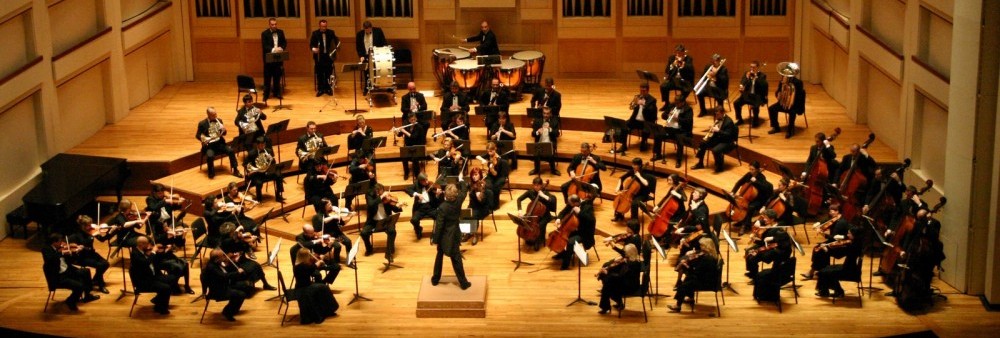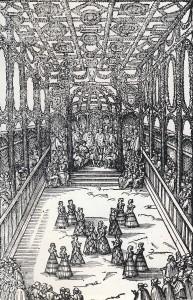Web page by: Kaley Meicher
Created April of 2014
asdfa
The Origins of Opera
Opera first appeared in Italy in the seventeenth century during the Baroque period. This new form of entertainment was arguably the most revolutionary addition to the Arts. Suddenly, numerous forms of artistic expression that had each separately been mastered were combined to make one spectacular production. Opera had it all: drama, music, dancing, architecture, paintings, literature, and acting.

- The Origins of Opera by Kaley Meicher, licensed under CC BY
ERT
The Standout Operas

- The Stars of Opera by Kaley Meicher, licensed under CC BY
Although Opera began during the Baroque period, that is not where it ended. This revolutionary form of entertainment continued to awe audiences during the Classical and Romantic periods as well. Throughout these time periods many superb composers added to the beauty of opera. Click the image called “The Stars of Opera” to the right in order to view a prezi of famous composers and some of their popular operas.
FF
Opera’s Impacts
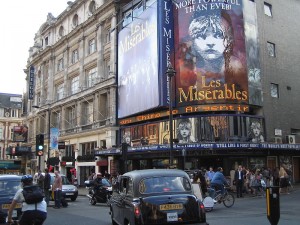
- Les Miserables at Queen’s Theatre
by Rifleman 82, used under CC0
Even now, in the 21st century, opera continues to hold its place in the artistic world. New forms of artistic expression have evolved from the traditional opera including ballets and musicals (musicals contain dialogue as well as musical numbers, while operas have no dialogue). As discussed below: ballet has especially proved to be one of the most revolutionary forms of art. When the unique idea of combining many different areas of art into one performance was introduced it may have seemed impossible; many artists would have to work together to meld their unique inputs into one masterpiece. However, once this feat was accomplished a new form of entertainment more glorious and beautiful than any single form of art alone was created. Opera, and its multiple spin-offs, have shaped the world of art as we know it (Manoff, 1982).
♦—♦—♦—♦—♦—♦—♦—♦—♦—♦—♦—♦—♦—♦—♦—♦—♦—♦—♦—♦—♦—♦—♦—♦—♦—♦
Early Ballet
Early ballet began with dances that were only done by nobility for celebrations (Pittsburgh Ballet Theatre). Then, when opera was introduced to the world, ballet was one of the art forms intertwined within it (Manoff, 1982). The opera was a means for ballet to spread, and in no time people fell in love with this art form. Some believed that ballet deserved to stand on its own. Jean Georges Noverre was one of the loudest advocates for this viewpoint.
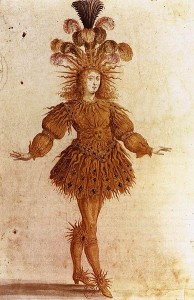
- Ballet de la nuit
by Henri Gissey, used under CC BY-SA
He thought that the dialogue of the opera was unnecessary, and in fact took away from the beauty of the ballerina’s movements. He believed that the storyline could be beautifully depicted through the actions of the ballerina and the music. This opinion was revolutionary in that it influenced ballet productions to stand on their own and created an emphasis on the beauty of movement (Sydnor, Martin, Brown).
wrwret
WERTW
NOTE: If you would like to see a more in-depth presentation of major points in ballet’s history click the picture below to link to a prezi presentation.
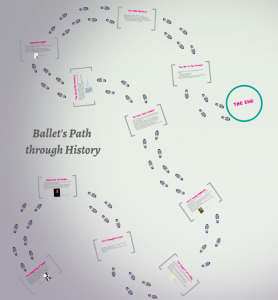
- Ballet’s Path
by Kaley Meicher, licensed under CC BY
ERT
Ballet and Equality
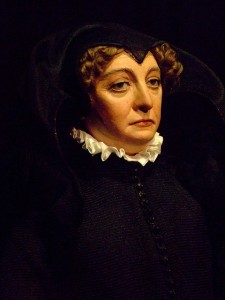
- Historical Portrait Figure of Catherine de Medici
by George Stuart, used under CC BY-NC-SA
Ballet’s transition from the courtroom to the opera was revolutionary because it allowed normal people to dance, instead of just noblemen and noblewomen. This was not ballet’s only step towards equality; it also helped make some dramatic leaps among gender equality. In its early days, women were not allowed to perform. Even when a female role was required, a man simply had to wear a mask and play the girl’s part. Ballet was in for a world of change once women were allowed to participate. In Le Triomphe de l’Amour, the first female ballerinas performed. This first step opened a door, and by the 1800’s females dominated the stage (Tsiounis).
EWRT
Skirts above the Ankles
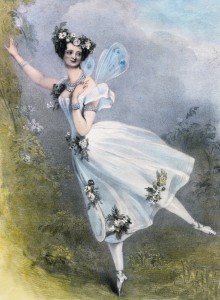
- Marie Taglioni in Zephire
by Richard J. Lane, used under CC0
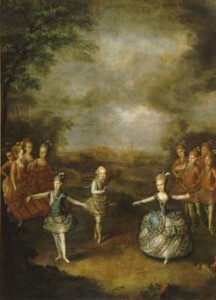
- le Triomphe de l’amour
by Johann Georg Weikert, used under CC0
The ballerina’s costume also underwent drastic changes throughout the years. In order to display their intricate steps, ballerinas shortened their full-length skirts to go above the ankle. This at first created a bit of an uproar, but as time went on people grew to appreciate the difficult choreography they were performing and forgot about the issue of showing ankles. Slowly but surely the skirts continued to shorten in order for the ballerinas to perform easier and show off their talent. This shortening would lead to the modern day tutu (Sydnor, Martin, & Brown).

- Ballet Shoes Line
by Jeff Medaugh, used under CC BY-SA
T
Ballet’s Influence

- La Sylphide
by Louis Maleuvre, used under CC0
Ballet was revolutionary in and of itself; it was an entire new and unique form of artistic expression. It showcased the beauty and storytelling that could be created through only body movements and music (Sydnor, Martin, Brown). This revolution proves itself to be influential by the sheer number of dance schools all around the world today. Ballet also contributed to another revolutionary concept: equality. Although in the early times of the ballet women were not allowed to dance, the norm was reversed as women wedged their foot into the door and later dominated the art. Ballet also has roots in court dancing among nobility. It was one activity among many that required the partaker to be of high blood to become involved. With time, other people were allowed to dance, and soon the dancers were chosen by talent and not by lineage. The movement towards equality among social classes and women add to the importance and revolutionary presence of this art.
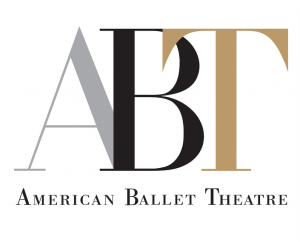
- ABT logo
by American Ballet Theatre, used under CC0
Now is your chance to get the inside scoop on the modern day world of ballet. Click here to read an interview with Jennifer Homans: the author of Apollo’s Angels, a historian, and a former professional ballet dancer. Also, above is the logo of a very prominent ballet company from the modern day.
